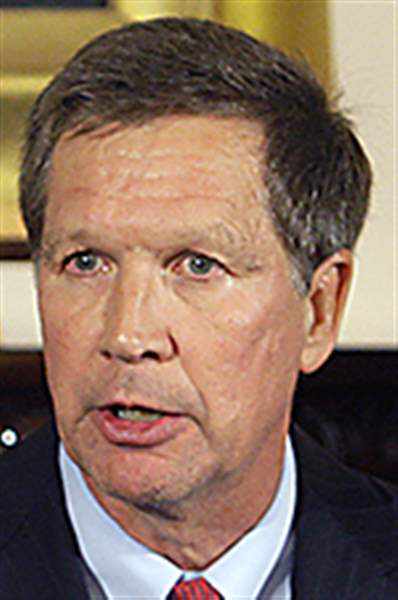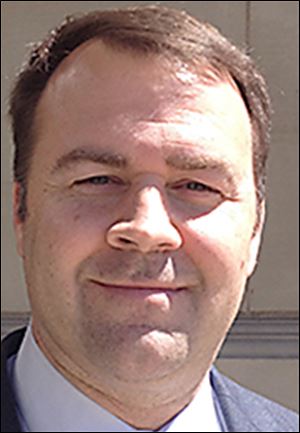
EDITORIAL
Campaign addiction
Gov. Kasich has a duty to his constituents, especially the victims of this epidemic, to debate his record on addiction
7/13/2014
Kasich
ASSOCIATED PRESS

Kasich
Heroin and opioid addiction is a statewide epidemic, a medical crisis, and a public-health emergency. It’s also a top-tier campaign issue in this year’s races for Ohio governor and attorney general.
That’s entirely appropriate, despite suggestions from Republicans and the administration of Gov. John Kasich that the issue should remain above politics.
Click here to read more Blade editorials.
RELATED: Blessed by a brutal addiction
RELATED: Let’s fight this epidemic without hysteria
Fatal heroin-related overdoses in Ohio have tripled in the past three years, to more than 1,000 a year. An estimated 200,000 Ohioans are addicted to opioids.
To be sure, candidates should not exploit the enormous suffering caused by this epidemic. And neither Ed FitzGerald, the Democratic gubernatorial nominee, nor David Pepper, the Democratic candidate for attorney general, has done so.
But citing the misery of addiction to dodge relevant questions is equally troubling. Voters need a vigorous debate to help them decide who can best manage this insidious epidemic.
Unlike his challenger, Governor Kasich did not respond to requests from The Blade, made through his spokesman, for an interview. That’s unfortunate. Northwest Ohio voters need to know how all the candidates would manage how opioids are prescribed, expand effective treatment, and take heroin and illicit prescription painkillers off the street.
This epidemic is not fading. The number of heroin-related fatal overdoes in the Toledo area is on pace nearly to double again this year, to 130 or more.
Governor’s record

DeWine
Mr. Kasich has a record he can defend, despite cutting state aid to local governments and treatment providers and undermining their ability to treat addiction and enforce drug laws. To reduce the demand for opioids, the governor needs to expand effective treatment, especially medication-assisted treatment, which has demonstrated great success using drugs such as Suboxone and methadone to alleviate painful withdrawal symptoms.

FitzGerald
In 2011, Mr. Kasich appointed his Cabinet Opiate Action Team to coordinate efforts on addiction and overdoses. Working with medical providers and others, the team issued voluntary guidelines for prescribing painkillers such as Vicodin, Percocet, and OxyContin. The guidelines dramatically reduced prescriptions containing dangerously high doses of opioids.

Pepper
The governor worked with the General Assembly to strengthen licensing rules for pain-management clinics, close 13 pill mills, and open an addiction treatment center in southern Ohio.
Mr. Kasich also launched “Start Talking!”, a prevention initiative for middle and high school students. It promotes conversations between young people and parents, guardians, and others about drug abuse and health.
This spring, the governor signed legislation that, among other things, expands the use of naloxone — a life-saving drug that reverses the effects of opiate overdoses — and requires hospitals to report the number of newborns diagnosed as opioid-dependent.
Seeking effective treatment models, the Kasich administration created a three-year, $4.2-million pilot program for addicted mothers and their drug-dependent babies in Cleveland, Columbus, Cincinnati, and Athens. The MOMS project (Maternal Opiate Medical Supports) uses medication-assisted treatment and other supports to reduce, by 30 percent, costly hospital stays for infants. This year, the administration funded medication-assisted treatment in drug courts in six counties.
Mr. Kasich’s most sweeping achievement was expanding Medicaid in Ohio, pumping hundreds of millions of dollars into the health-care system and freeing up money for local services by providing care to addicted and mentally ill people who were uninsured.
What the governor hasn’t done is assess, with current information, the overall treatment needs of Ohioans and propose an adequate statewide treatment network, as well as a way to pay for it. Now, only one in 10 of those who need treatment gets it. Making matters worse is the dearth of medication-assisted treatment programs.
Moreover, budget changes enacted this year will cost local mental health and addiction boards, and the community agencies they fund, millions of dollars. Lucas County expects to lose $2.4 million in state funding, dipping to $3.9 million next year, even as heroin-related overdoses continue to soar.
More broadly, Mr. Kasich has pursued a misguided policy of regressive tax cuts. He reduced state funding to local governments by about half, leaving hundreds of millions of dollars less to cope with local emergencies.
Challengers’ ideas
Mr. FitzGerald prudently proposes a statewide assessment of treatment needs, as well as a plan to pay for them. He does not rule out a tax increase to fight what he correctly calls a public-health emergency. Nor should he: A statewide health emergency should take priority in the budget.
Ohio’s official tally for fatal opioid and heroin-related overdoses, issued by the Department of Health, is more than a year old. Outdated data should not drive new programs. Mr. FitzGerald and Mr. Pepper propose using technology to get real-time information on local overdoses, drug trafficking, and other trends. The candidates would focus treatment and law enforcement resources on “hot spots,” areas with exceptional needs.
Mr. Pepper has become Ohio’s most forceful advocate of expanding effective treatment for opioid addiction, though the attorney general’s office is not generally responsible for such programs. In an interview with The Blade’s editorial page, Mr. Pepper vowed, if he is elected, to ask the General Assembly to fund evidence-based treatment programs, especially medication-assisted treatment, and get naloxone kits to every county in Ohio.
He also plans to pursue litigation against pharmaceutical companies that understated the risks of addiction for prescription painkillers such as Vicodin, Percocet, and OxyContin, using any settlement awards to fund treatment.
In speeches across the state, Attorney General Mike DeWine repeats the mantra that Ohio can’t arrest its way out of its drug problem. He has hired three people — two of them mothers who have lost a child to an overdose— to help communities set up grass-roots education and prevention efforts.
Mr. DeWine has conducted a dozen town-hall meetings statewide on opioid addiction — an effort Mr. Pepper dismissed as “pep talks” and “show and tell.” But Mr. DeWine was right to use his bully pulpit to raise public awareness, especially in Ohio’s suburbs, where many people continued to deny their communities had a drug problem.
Last November, Mr. DeWine initiated a $1 million heroin unit to work with local law enforcement on interdiction. A long-term effort aimed at large-scale dealers, the unit has yet to show results.
The campaigns for governor and attorney general continue to raise awareness of Ohio’s heroin and opioid epidemic. More important, they enable voters to assess what the governor and attorney general have done, and would do in a second term. Likewise, the Democratic challengers can make a case that they could do the job better.
At a conference in Columbus last month, Governor Kasich called Ohio’s joint efforts to alleviate addiction a crusade. His desire to help the people who suffer most from this epidemic, as well as their families and friends, appears genuine, even heartfelt.
He can best do that now by joining this debate and explaining what he, given four more years, would do to make things better.